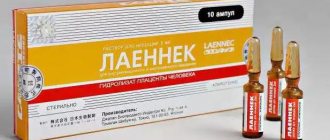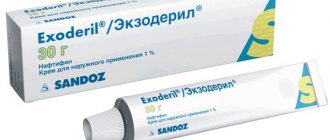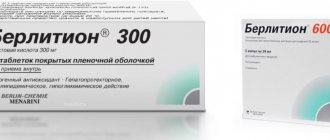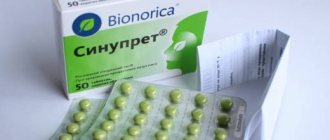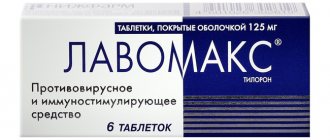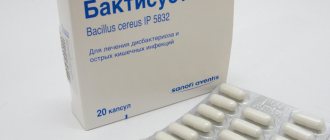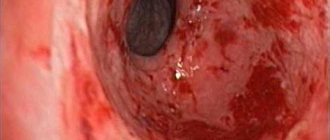Dalargin is a treatment for peptic ulcers.
Description and application:
- Tradename
- International nonproprietary name
- Dosage form and description
- Composition and release form
- Pharmacological group
- Pharmacological properties
- Pharmacodynamics
- Pharmacokinetics
- Indications for use
- Contraindications
- Directions for use and doses
- Side effect
- Overdose
- Interaction with other drugs
- special instructions
- Use during pregnancy and lactation
- Interaction with alcohol
- Impact on the ability to drive vehicles and other mechanical means
- Storage conditions and shelf life
- Conditions for dispensing from pharmacies
- Analogs
- Opinion survey results
Pharmacological properties
It has antihypertensive properties, promotes the healing of stomach and duodenal ulcers, and reduces the acidity of gastric juice.
Pharmacodynamics
Dalargin is a synthetic hexapeptide and an analogue of leucine enkephalin. It is a proteolysis inhibitor and ensures healing of gastric and duodenal ulcers. Tyrosyl-D-alanyl-glycyl-phenylalanyl-leucyl-arginine diacetate is characterized by moderate antisecretory activity. It also helps reduce the acidity of gastric juice and inhibits the exocrine secretion of the pancreas, which manifests itself as a reaction to various stimuli (food intake, secretin, etc.).
An experiment in which patients with pancreatic lesions participated confirms that Dalargin reduces hyperenzymemia, limits necrotic foci and promotes the regeneration of full tissue in their place, and also reduces the production of proteolytic enzymes by the pancreas. In addition, the drug has a weak hypotensive effect.
Pharmacokinetics
The pharmacokinetics of the drug remains insufficiently studied.
Domestic drug dalargin and its use in oncology
Nikolaev A.V., Slepushkin V.D. Novokuznetsk branch of the Institute of General Reanimatology of the Russian Academy of Medical Sciences
Under this sky, life is a series of torments, but will it take pity on us? Never! O unborn ones! If you had a chance to know about our torments, you would not have come here.
OMAR KHAYYAM
Medical care for cancer patients in Russia noticeably lags behind its needs due to the increase in morbidity. Thus, the number of patients with a first diagnosis of malignant neoplasm increased from 1991 to 1996. by 7% and reached 422 thousand people, which corresponds to an average of one disease being registered every 1.3 minutes. In 2000, the number of new cases of disease is expected to increase to 480 thousand (2). Due to mortality from malignant neoplasms, the Russian population lost 4.5 million person-years of life in 1996 (2, 14).
The growth of a malignant tumor in the body, already at an early stage of its development, is accompanied by certain changes in metabolism. Disturbances develop in the aerobic and anaerobic phases of carbohydrate metabolism, the nature of oxidative processes, protein and lipid metabolism changes, which is accompanied by the phenomenon of increasing intoxication and dysfunction of organs and systems. The changes that occur in the body of a patient with a malignant tumor depend on the location of the tumor and its prevalence. Significant disturbances in protein-nitrogen metabolism develop in the patient's body, which are associated with increased consumption of nitrogenous products by tumor tissue and are caused by the need to provide it with plastic material. With limited intake of proteins into the body, due to disruption of the digestive tract, these disorders are further aggravated. This leads to a decrease in blood volume, mainly due to a decrease in circulating protein, the development of hypochromic anemia, chronic hypoxia, and metabolic acidosis. As a result, functional changes in the cardiovascular and respiratory systems develop. According to ECG data, diffuse metabolic changes in the myocardium are detected in 85% of cases in patients with esophageal cancer and are combined with impaired conductivity and excitability of the myocardium. In patients with malignant neoplasms of the esophagus, decreases in MOS and SOS develop, and disturbances in the contractility of the right ventricle of the heart are detected. In the pathology of the respiratory system, as a rule, mixed or obstructive types of pulmonary ventilation impairment predominate, and chronic bronchitis often develops. There is a decrease in VC and MVL with a compensatory increase in MOD.
Disturbances of homeostasis in elderly and senile patients associated with a malignant tumor are often aggravated by concomitant diseases of the cardiovascular and respiratory systems. Thus, in particular, in patients with esophageal tumors, pulmonary emphysema, hypertension, coronary artery disease, and disorders of the structure and function of the liver and kidneys are most often recorded as concomitant diseases.
Radiation treatment and chemotherapy or their combination before surgery are accompanied by certain unfavorable changes in the body of patients. Radiation treatment in therapeutic doses aggravates disorders of protein-nitrogen metabolism. There is a further decrease in BCC. Penetrating radiation causes vasodilation and increases capillary permeability. The effect of vasodilation leads to a discrepancy between the blood volume and the capacity of the vascular bed, which affects changes in blood flow in the periphery. The total peripheral resistance decreases, which is accompanied by an increase in metabolic disorders and further dysfunction of the heart muscle. Tachycardia increases, blood pressure decreases. The most pronounced effects of radiation exposure are in patients with tumor localization near vital organs - the heart and lungs.
Currently, the main treatment method for cancer patients is still surgery. Surgical treatment for a malignant tumor is often the only means of cure or prolongation of life for the patient. In this regard, indications for surgical treatment of cancer patients are considered justified. Operations performed for malignant neoplasms are among the most extensive and traumatic in surgery, and the treatment plan often involves several surgical interventions on the same patient. In our opinion, the main ways to overcome difficulties in treating this category of patients can be adequate protection of patients at the stages of preparation for surgical treatment, during surgery and after surgery. In cases where surgery and chemoradiotherapy are ineffective, there is a need for equally adequate symptomatic therapy aimed at improving the patient’s quality of life.
Despite the efforts made and undoubted successes at this stage of development of anesthesiology, there is reason to conclude that none of the existing drugs and methods of general anesthesia guarantee adequate protection from the action of damaging stress factors during the treatment of cancer patients. However, in our opinion, the emergence of some clinical and experimental work in this direction deserves more significant attention. Currently, the attention of doctors of various specialties is attracted by a group of substances related to “opioid peptides”. This is primarily due to the fact that the opioid system is an important part of the human antinociceptive system, and, therefore, analogues of this group of drugs have high analgesic activity (2). In addition, the important role of the opioidergic system in the regulation of cellular metabolism, the formation of stress-implementing and stress-limiting processes has now been proven. These features, the physiological versatility of the function of this system, are the basis for the increased interest in the domestic opioid peptide - dalargin.
To date, dalargin is the only drug from the group of neuropeptides that is approved by the Pharmacological Committee of the Russian Ministry of Health for extensive clinical trials (1). Initially created for the treatment of peptic ulcers, this drug began to be used in a number of other areas of medicine, including as a component of preoperative protection, anesthetic management and intensive care in cancer patients. The prerequisites for the use of dalargin in cancer patients were scientific and practical studies on the study of neuropeptides.
It has now been established that dalargin:
- Reduces gastric and intestinal motility with simultaneous contraction of the pylorus;
- Inhibits gastric secretion, reduces the activity of pancreatic enzymes;
- Improves lymph circulation and stimulates lymph flow, including in the pancreas;
- Improves microcirculation;
- It has antihypoxic properties comparable to the effects of sodium and lithium hydroxybutyrate;
- Causes fairly long-lasting analgesia when used epidurally (5, 6, 7);
- Compatible with opiates, opioids, local anesthetics, capable of potentiating the effects of sedation and analgesia (5, 6, 7);
- Has an immunomodulatory effect;
- Capable of stimulating the regeneration of skin, subcutaneous tissue, nervous and bone tissue, and liver;
- It has an anti-stress effect and belongs to the endogenous anti-stress system (9, 10, 11);
- Helps improve kidney function (for example, in shock), normalizes the excretion of electrolytes and their content in the blood plasma (12)
The presence of a number of positive pharmacological properties and unique clinical effects of the drug allowed us to use dalargin in cancer patients at the stage of preoperative preparation (premedication), during the period of general anesthesia, for the purpose of postoperative epidural anesthesia, for the prevention and treatment of postoperative pancreatitis, for pain relief in incurable patients. For the first time, we used the method of epidural autoanalgesia with dalargin in cancer patients with secondary changes in the pelvic bones, lung cancer, pancreatic and prostate glands, and kidney cancer (5, 6, 7).
When using dalargin for premedication in cancer patients, we observed a stable stress-protective effect, which was confirmed by stable hemodynamics (the decrease in blood pressure was no more than 10% of the original), physiological levels of cortisol and glucose in the blood. It was found that patients receiving dalargin did not experience a pronounced sedative effect, but there were no manifestations of anxiety and agitation. A more stable emotional background was created with a positive attitude towards surgical intervention. In other words, the synthetic neuropeptide dalargin helps bring the patient’s condition closer to the autogenous norm of neuropsychic well-being (6). We noted that in patients undergoing surgery for tumors of the gastrointestinal tract, less gastric contents were evacuated on the operating table, which indicated inhibition of gastric secretion and the secretory ability of the pancreas, as well as the stimulating effect of dalargin on the contractile function of the pylorus (6, 9, 11, 13).
We also found that the course of anesthesia using dalargin as an additional component of general anesthesia during extensive oncological operations was characterized by controllability with the absence of circulatory reactions (BP and pulse) and stability of cortisol and glycemic levels. Recovery from anesthesia of patients receiving dalargin as part of the general anesthesia regimen was not accompanied by muscle hyperkinesis and microcirculation disorders. Postoperative analgesia persisted for up to 4 ± 0.5 hours. It should be noted that dalargin is compatible with narcotic analgesics and can potentiate their effect, but cannot be used independently for pain relief, since when administered intravenously it has low analgesic activity and does not last long, probably quickly destroyed by enkephalinases.
We believe that the use of dalargin for premedication and in the general anesthesia regimen in cancer patients is justified, since the drug limits the activity of the sympathoadrenal system, which is essential for the immediate and long-term results of treatment.
It is worth pointing out the high therapeutic activity of long-term epidural blockades with dalargin for the prevention and treatment of acute postoperative pancreatitis in cancer patients undergoing surgery on the abdominal organs. The use of long-term therapeutic epidural blockade with dalargin in the postoperative period interrupts the pathogenetic mechanisms of the development of acute postoperative pancreatitis, promotes complete pain relief in this period, normalizes intestinal motility in the early stages and improves postoperative wound healing. This significantly reduces the length of time a patient stays in bed and reduces the cost of treatment.
The experience of endolymphatic administration of dalargin during onco-abdominal operations, when the drug is injected into the lymph node of the mesenteric root, deserves attention (13). In this case, long-term postoperative analgesia is ensured, adequate function of physiological systems is ensured, and homeostasis is maintained in the optimal range.
Currently, the importance of pain relief in cancer patients has increased even more due to the fact that the success of chemotherapy for malignant tumors has made it possible to carry out long-term specific treatment, but due to the pain syndrome this is not always possible. There is a need to especially emphasize that the issue of treating patients with pain syndrome, in addition to medical, also has great economic and social significance, as well as a humane aspect in connection with the reduction of severe suffering of patients.
It is reliably known that out of 6 million people with cancer, 3.5 million suffer from pain every day around the world, 25% of all cancer patients in the world die without effective help. A number of foreign authors indicate that about 40% of patients with intermediate stages of the disease and 60–87% with generalization of the tumor process experience moderate to severe pain (3).
Currently, the organization of specialized rooms, departments and even clinics for the treatment of patients with only pain syndrome continues (the first was organized in 1961 by Bonica and Watts in the USA). It is considered advisable to have an analgesiologist on the staff of large clinics, however, in most cases this is a difficult privilege for enthusiastic doctors of various specialties who master the art of treating pain independently, on their own initiative.
The main role in the treatment of pain syndromes of various origins, especially in advanced stages of malignant neoplasms, belongs to narcotic and non-narcotic analgesics, or their combination. This is the most common type of treatment in a hospital, in a clinic and at home, which is explained by its effectiveness in the first stages for many types of pain, convenience for the patient and the doctor.
The problem of pain relief today cannot be considered solved, despite a significant arsenal of new pharmacological agents and methods.
In our opinion, a promising direction in the treatment of cancer pain may be the epidural use of dalargin in the autoanalgesic mode. Our study in this direction showed that the intensity of the pain syndrome during the period of prolonged autoanalgesia with dalargin was completely under the control of the patient and the doctor, which ultimately had a positive impact on the quality of life not only of the patient, but also of his environment.
When using the method of prolonged epidural autoanalgesia with dalargin, patients felt much more confident and calm, since they could independently relieve pain in the early stages of its increase, regardless of the services of medical personnel and relatives, there was no nausea, vomiting, drowsiness, itching, urinary and stool retention, there was no respiratory depression. With epidural administration of dalargin, moderate (10–12% of the initial) and short-term (15–20 min) hemodynamic depression was noted, however, no serious disturbances in the most important vital functions were detected.
Each stage of our study was confirmed clinically and laboratory and had a number of advantages over standard methods of therapy in this category of patients. In this case, a positive role was played by the fact that dalargin, being a natural metabolite of the body, is practically devoid of toxic properties.
Experimental studies conducted on mice showed that dalargin at a dose of 100 μg/kg exhibited an antitumor effect (9) on models of transplantable tumors - Ehrlich ascitic carcinoma, Pliss lymphosarcoma (L.V. Ratakhina, V.P. Pashinsky, 1984).
From the presented data it is clear that neuropeptides influence the functions of many, if not all organs and systems, various aspects of metabolic processes in the human and animal bodies (8, 9, 13). This polymorphism of action has an evolutionary justification. It is known that neuropeptides are found in almost all representatives of the animal world, starting with annelids. This suggests that neuropeptides at lower stages of evolution play a regulatory role, and with the emergence of the endocrine and central nervous systems, they become a kind of connecting link between them, acting as modulators of physiological functions (9).
We are not trying to present dalargin as a panacea? the history of medicine knows similar cases, in particular with regard to glucocorticoids (9), so this feature may raise doubts among a number of clinicians about the effectiveness of the drug. Further research and observations will determine the place of this drug in the arsenal of pharmacological agents. Considering the nature of the changes detected in the body of a cancer patient, the use of dalargin during chemoradiotherapy in cancer patients may be promising and justified.
In our opinion, the use of dalargin in cancer patients is pathogenetically and clinically justified and deserves further detailed study. The most important advantage that determines the active introduction into clinical practice of newly created drugs based on neuropeptides is that they will be analogues of endogenous biological compounds. Consequently, these drugs will contribute to the implementation of natural processes occurring in the body of humans and animals. The ability of neuropeptides to modulate endogenous processes without grossly affecting homeostasis parameters seems to us unique and promising. The use of dalargin at various stages of treatment of cancer patients and its combination with other drugs will open up new possibilities for its use in modern oncology and anesthesiology, increase patient safety and, ultimately, have a positive impact on the quality and length of life.
Used Books
- Bredikhin A.Yu., Prikhodko V.V., Dolgov A.M. Comparative assessment of the effect of opioids and benzodiazepines on psychoemotional status and pain threshold in the preoperative period. Current problems of spinal and epidural anesthesia. Ekaterinburg, 1996, pp. 16 – 17.
- Dvoirin V.V. Statistics of malignant neoplasms in Russia, 1990. Bulletin of the Research Center of the Academy of Medical Sciences of Russia, 1992, No. 4. -With. 3 – 14.
- Isakova M.E., Pavlova Z.V., Laktionov K.P. Treatment of pain syndrome in cancer patients
- patients M., 1994.
- Likhvantsev V.V., Smirnov V.I., Sitnikov A.E. Prospects for the use of small regulatory peptides in anesthesiology and intensive care. Bulletin of Intensive Care No. 1, 1994, p. 39 – 42.
- Mikhailov N.N., Slepushkin V.D., Vyalov V.N. The effect of dalargin on water-salt metabolism in rats with crash syndrome. Bulletin of Intensive Care No. 1, 1994, p. 47 – 49.
- Nikolaev A.V., Polekhin A.E., Kuznetsov D.I., Voitsitsky V.E. Prolonged epidural analgesia with dalargin for secondary changes in the pelvic bones in cancer patients. Current issues of modern medicine. 8th scientific and practical conference of doctors, Novosibirsk, 1998, p. 35.
- Nikolaev A.V., Polekhin A.E. Premedication with dalargin in cancer patients. J. Consilium No. 1, Novosibirsk, 1998, p. 22.
- Nikolaev A.V., Rovina A.K., Voitsitsky V.E., Pushkarev S.V. Prolonged epidural anesthesia in cancer patients. Palliative medicine and rehabilitation No. 2 - 3, 1998, Moscow, - 164.
- Nikolaev A.V., Lepeshkin G.P., Pushkarev S.V., Skuridina I.V., Voitsitsky V.E. Relief of chronic pain syndrome in cancer patients using prolonged epidural anesthesia. Current issues in oncology. Kemerovo, 1997, p. 134 – 135.
- Slepushkin V.D., Zoloev G.K., Vinogradov V.A., Titov M.I. // Neuropeptides. Their role in physiology and pathology //. Tomsk, 1988.
- Slepushkin V.D. Use of neuropeptides in the clinic. // Methodological recommendations for medical cadets //. Novokuznetsk, 1993.
- Slepushkin V.D. Neuropeptides in anesthesiology and resuscitation. // Anest. and intensive care unit. – 1997, – No. 6. – p. 59 – 61.
- Slepushkin V.D. Mechanisms of pathological reactions. Novokuznetsk, 1991, - p. 81 – 83.
- Slepushkin V.D., Gresler Y. Anest. and resuscitator. No. 6, 1990, - p. 15 – 17.
- Slepushkin V.D. Use of dalargin in anesthesiology and intensive care. Bulletin of Intensive Care No. 1, 1996, p. 7 – 8.
- Trapeznikov N.N., Aksel E.M., Barmina N.M. Morbidity and mortality from malignant neoplasms of the Russian population in 1996. Russian Medical Journal, Vol. 6, No. 10, 1998, p. 616 – 620.
- Terenius J. Endorphins. Per. from English Moscow, 1981. – p. 315 – 326.
- Zoloev GK et al. Cor. et vasa (Praha). – 1989. – Vol. 31, No. 3. – R. 203 – 220.
blog comments powered by Disqus
Directions for use and doses
Dalargin in the form of a solution and lyophilisate is administered intravenously or intramuscularly.
To use the lyophilisate, the contents of the ampoule must be dissolved in 1 ml of isotonic 0.9% sodium chloride solution immediately before administration.
Dosage of the drug in the treatment of acute forms of the disease:
- Duodenal and stomach ulcers: single dose 1-2 mg, daily dose - no more than 5 mg, total course dose - from 30 to 50 mg. The treatment period is from 21 to 28 days;
- Pancreatitis: 2 mg intravenously, then 5 mg 1 or 2 times a day, for 4–6 days;
- Pancreatic necrosis: 5 mg 3 to 4 times a day is administered intravenously, maintaining regular intervals between procedures. The treatment period is 2–6 days.
Composition and release form
The drug "Dalargin" (analogues, instructions for use are indicated in this article) is available in two forms: in the form of a powder and a solution for injection.
The powder or lyophilisate is white in color and has a slight odor of acetic acid. Available in ampoules, 1 mg each. The bottles are placed in cardboard packaging. One such box contains five ampoules and instructions for use.
But injection solutions are sold ready-made. They look like a transparent liquid without color and special odor. The injection solution, just like the powder, is available in one milliliter ampoules.
Each bottle is located in a designated cell and placed in a cardboard package.
special instructions
Use during pregnancy and lactation
The safety of using Dalargin during breastfeeding and in pediatric patients has not been established. Use during pregnancy and lactation is contraindicated.
Interaction with alcohol
The manufacturer has not provided data on the interaction of Dalargin with alcohol.
Impact on the ability to drive vehicles and other mechanical means
The manufacturer has not provided data on the effect of the drug on the speed of psychomotor reactions.

